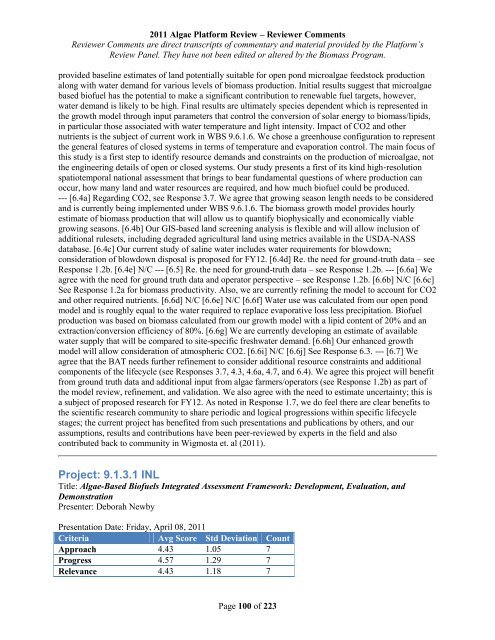Reviewer Comments - EERE
Reviewer Comments - EERE
Reviewer Comments - EERE
Create successful ePaper yourself
Turn your PDF publications into a flip-book with our unique Google optimized e-Paper software.
2011 Algae Platform Review – <strong>Reviewer</strong> <strong>Comments</strong><br />
<strong>Reviewer</strong> <strong>Comments</strong> are direct transcripts of commentary and material provided by the Platform’s<br />
Review Panel. They have not been edited or altered by the Biomass Program.<br />
provided baseline estimates of land potentially suitable for open pond microalgae feedstock production<br />
along with water demand for various levels of biomass production. Initial results suggest that microalgae<br />
based biofuel has the potential to make a significant contribution to renewable fuel targets, however,<br />
water demand is likely to be high. Final results are ultimately species dependent which is represented in<br />
the growth model through input parameters that control the conversion of solar energy to biomass/lipids,<br />
in particular those associated with water temperature and light intensity. Impact of CO2 and other<br />
nutrients is the subject of current work in WBS 9.6.1.6. We chose a greenhouse configuration to represent<br />
the general features of closed systems in terms of temperature and evaporation control. The main focus of<br />
this study is a first step to identify resource demands and constraints on the production of microalgae, not<br />
the engineering details of open or closed systems. Our study presents a first of its kind high‐resolution<br />
spatiotemporal national assessment that brings to bear fundamental questions of where production can<br />
occur, how many land and water resources are required, and how much biofuel could be produced.<br />
--- [6.4a] Regarding CO2, see Response 3.7. We agree that growing season length needs to be considered<br />
and is currently being implemented under WBS 9.6.1.6. The biomass growth model provides hourly<br />
estimate of biomass production that will allow us to quantify biophysically and economically viable<br />
growing seasons. [6.4b] Our GIS-based land screening analysis is flexible and will allow inclusion of<br />
additional rulesets, including degraded agricultural land using metrics available in the USDA-NASS<br />
database. [6.4c] Our current study of saline water includes water requirements for blowdown;<br />
consideration of blowdown disposal is proposed for FY12. [6.4d] Re. the need for ground-truth data – see<br />
Response 1.2b. [6.4e] N/C --- [6.5] Re. the need for ground-truth data – see Response 1.2b. --- [6.6a] We<br />
agree with the need for ground truth data and operator perspective – see Response 1.2b. [6.6b] N/C [6.6c]<br />
See Response 1.2a for biomass productivity. Also, we are currently refining the model to account for CO2<br />
and other required nutrients. [6.6d] N/C [6.6e] N/C [6.6f] Water use was calculated from our open pond<br />
model and is roughly equal to the water required to replace evaporative loss less precipitation. Biofuel<br />
production was based on biomass calculated from our growth model with a lipid content of 20% and an<br />
extraction/conversion efficiency of 80%. [6.6g] We are currently developing an estimate of available<br />
water supply that will be compared to site-specific freshwater demand. [6.6h] Our enhanced growth<br />
model will allow consideration of atmospheric CO2. [6.6i] N/C [6.6j] See Response 6.3. --- [6.7] We<br />
agree that the BAT needs further refinement to consider additional resource constraints and additional<br />
components of the lifecycle (see Responses 3.7, 4.3, 4.6a, 4.7, and 6.4). We agree this project will benefit<br />
from ground truth data and additional input from algae farmers/operators (see Response 1.2b) as part of<br />
the model review, refinement, and validation. We also agree with the need to estimate uncertainty; this is<br />
a subject of proposed research for FY12. As noted in Response 1.7, we do feel there are clear benefits to<br />
the scientific research community to share periodic and logical progressions within specific lifecycle<br />
stages; the current project has benefited from such presentations and publications by others, and our<br />
assumptions, results and contributions have been peer-reviewed by experts in the field and also<br />
contributed back to community in Wigmosta et. al (2011).<br />
Project: 9.1.3.1 INL<br />
Title: Algae-Based Biofuels Integrated Assessment Framework: Development, Evaluation, and<br />
Demonstration<br />
Presenter: Deborah Newby<br />
Presentation Date: Friday, April 08, 2011<br />
Criteria Avg Score Std Deviation Count<br />
Approach 4.43 1.05 7<br />
Progress 4.57 1.29 7<br />
Relevance 4.43 1.18 7<br />
Page 100 of 223




